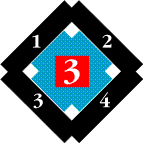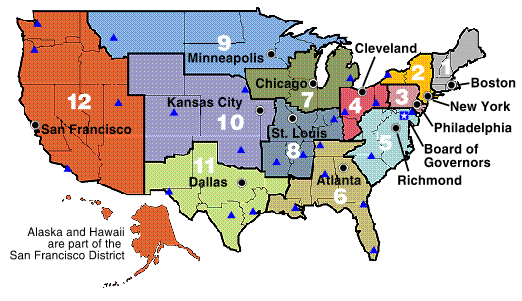
Federal Reserve
Banks
were established
by Congress as the operating arms of the nation's central banking system.
Many of the services provided by this network to depository institutions
and the government are similar to services provided by banks and thrift
institutions to business customers and individuals. Reserve Banks hold the
cash reserves of depository institutions and make loans to them. They move
currency and coin into and out of circulation, and collect and process
millions of checks each day. They provide checking accounts for the
Treasury, issue and redeem government securities, and act in other ways as
fiscal agent for the U.S. government. They supervise and examine member
banks for safety and soundness. The Reserve Banks also participate in the
activity that is the primary responsibility of the Federal Reserve System,
the setting of monetary policy.
For the purpose of carrying out these day-to-day operations of the Federal Reserve System, the nation has been divided into twelve Federal Reserve Districts, with Banks in Boston, New York, Philadelphia, Cleveland, Richmond, Atlanta, Chicago, St. Louis, Minneapolis, Kansas City, Dallas, and San Francisco. Twenty-five Branches of these Banks serve particular areas within each District.
The map shows locations of the Reserve Banks and their Branches, along with District boundaries and assigned District numbers.
Organization of the Banks
Federal
Reserve Banks operate under the general supervision of the Board of
Governors in Washington. Each Bank has a nine-member Board of Directors
that oversees its operations.
Federal Reserve Banks generate their own income, primarily from interest earned on government securities that are acquired in the course of Federal Reserve monetary policy actions. A secondary source of income is derived from the provision of priced services to depository institutions, as required by the Monetary Control Act of 1980. Federal Reserve Banks are not, however, operated for a profit, and each year they return to the U.S. Treasury all earnings in excess of Federal Reserve operating and other expenses.
Monetary Policy Role
The primary
responsibility of the central bank is to influence the flow of money and
credit in the nation's economy. The Federal Reserve Banks are involved in
this function in several ways. First, five of the twelve presidents of the
Federal Reserve Banks serve, along with the seven members of the Board of
Governors, as members of the Federal Open Market Committee (FOMC). The
president of the Federal Reserve Bank of New York serves on a continuous
basis; the other presidents serve one-year terms on a rotating basis. The
FOMC meets periodically in Washington, D.C., and determines policy with
respect to purchases and sales of government securities in the open
market, actions that in turn affect the availability of money and credit
in the economy.
Second, the boards of directors of the Federal Reserve Banks initiate changes in the discount rate, the rate of interest on loans made by Reserve Banks to depository institutions at the "discount window." Discount-rate changes must be approved by the Board of Governors. All depository institutions that are subject to reserve requirements set by the Federal Reserve—including commercial banks, mutual savings banks, savings and loan associations, and credit unions—have access to the discount window.
Each Federal Reserve Bank has a research staff to gather and analyze a wide range of economic data and to interpret conditions and developments in the economy. This research assists the FOMC in the formulation and implementation of monetary policy. It also contributes to informed decision making by the Federal Reserve Banks in bank supervisory matters and other areas. Most Reserve Banks publish a monthly or quarterly journal devoted to basic research and analysis of current economic issues in their District.

